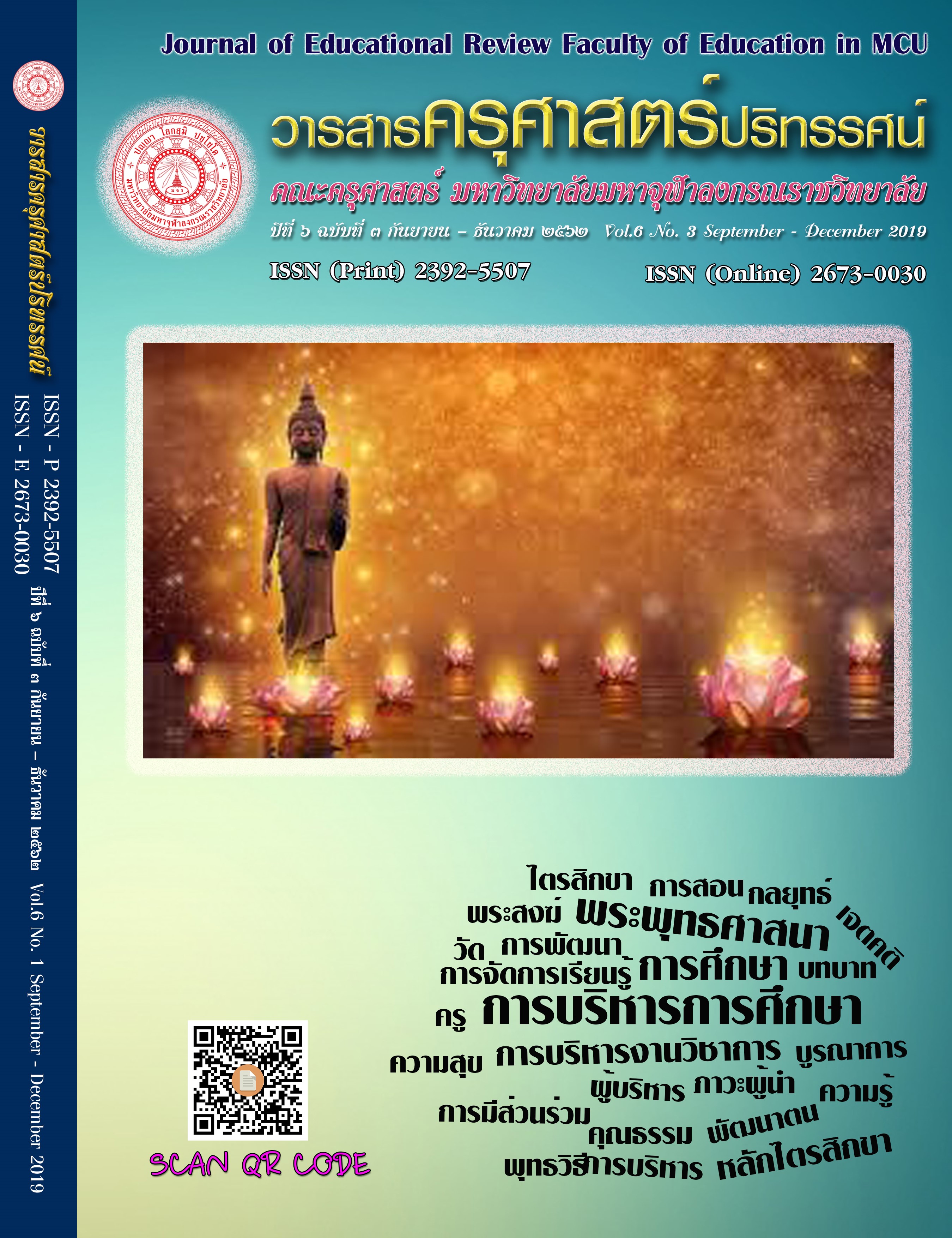THE DEVELOPMENT OF THAI LEARNING ACTIVITIES TO IMPROVE WRITING SPELLING ABILITY FOR PRATHOMSUKSA 3 STUDENTS
Main Article Content
Abstract
The purposes of this research were to develop and to find the efficiency of a Thai learning activities model in order to improve writing spelling ability of Prathomsuksa 3 students and to compare the spelling ability of Thai language courses of Prathomsuksa 3 students before and after using this model. This research used research methodology of Research and development (R&D) procedures exam before and after study. .The sample consisted of 26 Prathomsuksa 3 students of Wat Khao Noi School, Muang District, Kanchanaburi Province, under Kanchanaburi Primary Education Service Area Office 1, in the 1st semester of academic year 2018. The sample was selected by simple random sampling by drawing lots. The research tools were plans for learning Thai language activities to promote spelling ability, pre-test and post-test in the same exam, multiple choice (4 choices) of 30 items. The test had the reliability level of 1.00 . The statistics used in data analysis were percentage, mean, standard deviation. Data analysis was used to find efficiency E1/E2 which was equal to 80/80 and dependent t-test.
The results revealed that:
- The efficiency of this Thai learning activities model to improve writing spelling ability for Prathomsuksa 3 Students,and 5 Step learning activities as follows Step 1) To bring into the chapter Step 2) To read for improving skill Step 3) To write with enjoyable. Step 4) To Apply acknowledge Step 5) To correct handwriting To bring for the learning activity about the basic adjustment of spelling word E1/E2 was effective at 47 / 81.92.
- As for spelling ability in Thai language courses of Prathomsuksa 3 students, the mean score after studying was significantly higher than before learning at 0.05.
Article Details
ทัศนะและความคิดเห็นที่ปรากฏในบทความในวารสารฉบับนี้ถือเป็นความรับผิดชอบของผู้เขียนบทความนั้นเพียงผู้เดียว และไม่ถือเป็นทัศนะและความรับผิดชอบของกองบรรณาธิการ
กองบรรณาธิการขอสงวนสิทธิ์ในการคัดเลือกบทความลงตีพิมพ์และจะแจ้งให้เจ้าของบทความทราบหลังจากผู้ประเมินบทความตรวจอ่านบทความแล้ว
ต้นฉบับที่ได้รับการตีพิมพ์ในวารสารครุศาสตร์ปริทรรศน์ คณะครุศาสตร์ มหาวิทยาลัยมหาจุฬาลงกรณราชวิทยาลัย ถือเป็นกรรมสิทธิ์ของคณะครุศาสตร์ มหาวิทยาลัยมหาจุฬาลงกรณราชวิทยาลัย ห้ามนำข้อความทั้งหมดหรือบางส่วนไปพิมพ์ซ้ำ เว้นเสียแต่ว่าจะได้รับอนุญาตจากมหาวิทยาลัยฯ เป็นลายลักษณ์อักษร
References
จารีย์ ขุนชำนาญ. (2559). การพัฒนารูปแบบการจัดการเรียนรู้โดยใช้สมองเป็นฐาน (Brain-Based Learning : BBL) วารสารมหาวิทยาลัยมหามกุฏราชวิทยาลัย วิทยาเขตร้อยเอ็ด,5, 228-234.
ทิศนา แขมมณี. (2554). ศาสตร์การสอนองค์ความรู้เพื่อจัดกระบวนการเรียนรู้ที่มีประสิทธิภาพ. พิมพ์ครั้งที่ 10. กรุงเทพฯ : สำนักพิมพ์แห่งจุฬาลงกรณ์มหาวิทยาลัย.
บุญชม ศรีสะอาด. (2545). การวิจัยเบื้องต้น. (พิมพ์ครั้งที่ 7). กรุงเทพฯ: สุวีริยาสาส์น.
พงษ์เทพ บุญศรีโรจน์.(2533). เกมกับการเรียนรู้.วารสาร สสวท,69,18-19.
พุทธชาต ทองกร. (2551). นวัตกรรมที่แก้ปัญหาการจัดการเรียนการสอนอ่านภาษาไทย.วารสารวิชาการ, 11, ฉบับที่ 2 เมษายน - มิถุนายน 2551 ค้นจาก http://www.moe.go.th/ moe/th/news/detail.php?NewsID=13652&Key=hotnews
เยาวเรศ ผิวเหมาะ.(2561). การพัฒนารูปแบบการสอนตามแนวทฤษฎีการสร้างความรู้ของเยเกอร์ (Yager) โดยใช้ชุดกิจกรรมการเรียนรู้ เพื่อเพิ่มผลสัมฤทธิ์ด้านทักษะการอ่านและการเขียน กลุ่มสาระการเรียนรู้ภาษาไทย ของนักเรียนชั้นประถมศึกษาปีที่ 2 .มปท.
เรชา ชูสุวรรณ. (มปป). การพัฒนารูปแบบการจัดการเรียนการสอนภาษาไทยเพื่อพัฒนาความสามารถในการอ่านออกเขียนได้ของนักเรียนในสถานศึกษาขั้นพื้นฐาน จังหวัดนราธิวาส โดยใช้การจัดการความรู้.มปท.
วิลาวัลย์ กองสะดี. (2552). ปัจจัยที่มีผลต่อผลสัมฤทธิ์ทางการเรียนของนักศึกษารหัส 52 คณะบริหารธุรกิจวิทยาลัยราชพฤกษ์ปี การศึกษา2552.สาขาวิชาการตลาด คณะบริหารธุรกิจ วิทยาลัยราชพฤกษ์.
สมจิต จันทร์ฉาย. (2557). การออกแบบและพัฒนาการเรียนการสอน. นครปฐม : เพชรเกษมพริ้นติ้งกรุ๊ปจำกัด.
สุธีรา เผ่าโภคสถิตย์. (2543). จิตวิทยาทั่วไป.กรุงเทพฯ : สำนักพิมพ์แม็ค จำกัด.
อุษา ชูชาติ, และลัดดา อินทร์พิมพ์. (2558). บทวิเคราะห์ : มุมมองด้านการศึกษาของนายกรัฐมนตรี (พลเอกประยุทธ์ จันทร์โอชา).วารสารวิจัยการศึกษาสำนักงานเลขาธิการสภาการศึกษา,3,1-2
เอื้อมพร หลินเจริญ,สิริศักดิ์ อาจวิชัย ,และภีรภา จันทร์อินทร์. (2552). รายงานการวิจัย เรื่องปัจจัยเชิงสาเหตุที่ทําให้คะแนนการทดสอบ O-NET ของนักเรียนชั้นประถมศึกษาปีที่ 6 และชั้นมัธยมศึกษาปีที่ 6 ต่ำ.กรุงเทพฯ:สถาบันทดสอบทางการศึกษาแห่งชาติ (องค์การมหาชน).


